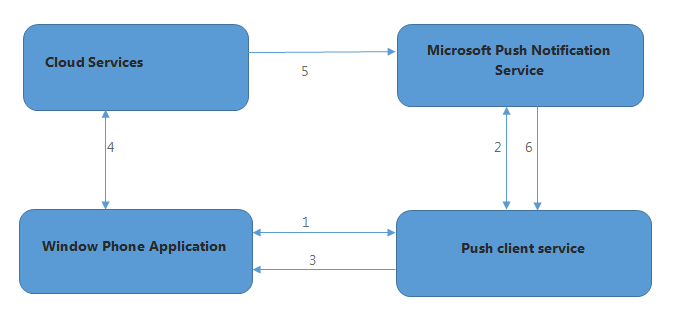A remote data provider web service is included in many mobile application to facilitates users with updated information or allow users to communicate with each other. For request and receive information mobile applications use ‘pull’ and the data provider service use ‘pushes’ updated information to mobile applications in the form of push notification. For updated data is available devices need not have check periodically by using push notification and there for battery life is conserved.
HttpNotificationChannel object is created by the app, which provides a unique URI – uniform resource identifier that uniquely identifies the phone where the app is installed and running. All application users uses their Uri token are uniquely generate by MPNS .User send message to another user using push notification to their URI.
Mobile application developers who target Windows Phone, Android and iPhone need a separate data provider for each type of device since they use different protocols for push notifications. Developers need to use the Microsoft Push Notification Service (MPNS) for Windows Phone, Cloud to Device Messages Framework(GCM) for Android devices and Devices the Apple Push Notification Service (APNS) for IOS devices. Mobile application developers need to manage different types of devices and they need to interface with each notification service in order to push messages.
The MPNS in Windows Phone is an best-effort, asynchronous service that offers third-party developers a channel to send data to a Windows Phone app from a cloud service in a power-efficient manner.
How it works
How a push notification is sent described by below diagram

I. Application will register on MPNS and URI will get back Application after registered successfully.
II. URI registered into Intermediate Server Database i.e. (Push client service) by calling web service.
III. The Push client service returns message to MPNS.
IV. MPNS will return message to related device by using related URI register on MPNS.
V. MPNS message will received on Mobile device.
VI. Rest will be depend on functionality.
The information is delivered as raw data to the app depending on the format of push notifications and the payload attached to it. A toast notification is displayed or the applications Tile is visually updated. Our cloud service gets a response code after a push notification is sent from MPNS indicating that the notification is received and in the next possible opportunity the notification will be delivered. In case of notification failure MPNS returns a response code or error code to the cloud service that indicates notification will not be delivered to the device. An end to end confirmation is not provided by MPNS for push notification was delivered to the phone by cloud service. Service can resubmit the notification if MPNS indicates notification will not be delivered.
Posted by-
Jitendra Kamlapuri
Disclaimer: Developer’s Corner Section of ISHIR blog is contributed and maintained by independent developers. The content herein is not necessarily validated by ISHIR.



